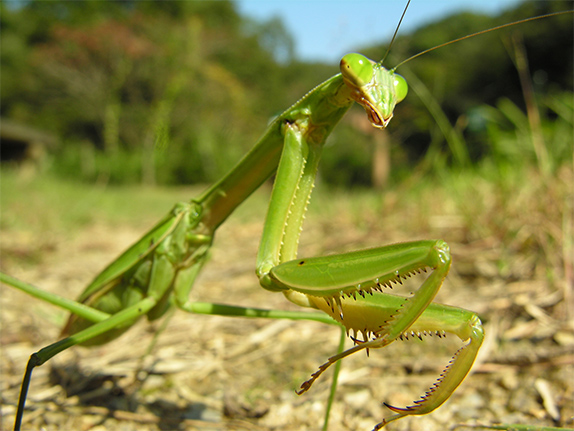
Spring is here and the bugs are out. There are numerous beneficial organisms in every yard and this is the main reason, plus your safety, for not using synthetic pesticides. They can be beneficial in different ways. Some are pollinators and we certainly need them. Others feed on decaying or dead plant or animal matter and they are important as well. The most important for a gardener are the predators who feed on plant pests.
Spiders, predatory mites and centipedes feed on numerous pests. It is hard to think of a centipede as beneficial, but the soil centipedes (Geophilomorpha) and stone centipedes (Lithobiomorpha) are very small centipedes that could not hurt a human or pet, but feed on numerous insects in a yard and many pest insects. Soil centipedes are very thin and long with many pairs of legs. They are normally subterranean and rarely seen. Stone centipedes are very small centipedes that resemble the larger ones that commonly scare people. Stone centipedes have 7 pairs of legs when born and end up with 15 pairs of legs when they reach adulthood. The larger centipedes we normally encounter (Scolopendromorpha) have 23 pairs of legs when they are born and the same number when grown. Both groups, soil and stone centipedes are very beneficial and should not be killed.
Some beneficial insects include praying mantis (Mantidae), which prey on a lot of insects and even kill and eat black widow spiders. I have had more than one person tell me that they frequently found dead mantids in their yard after pesticides were used.
Ladybird beetles (Coccinelidae), AKA ladybugs, are a major predator of aphids and other small pests. Ground beetles (Carabidae) are large, black beetle that feed on grubs and insect pupae. Many soft-winged flower beetles (Melyridae) are predators on pest species. Rove beetles (Staphylinidae) feed on grubs, insect pupae and root maggots, and in some cases, aphids. There are other beetles that are beneficial. If in doubt about a bug, get it identified, so you don't kill something that is a good bug.
The hoverfly (Syrphidae) feeds on nectar in the adult stage, but in some species, the larval stage is a predator of aphids. Some true bugs (Hemiptera) are beneficial, such as assassin bugs (Reduviidae), which hide under leaves and ambush caterpillars. Minute pirate bugs (Anthocoridae) are very small and prey on thrips and other small pests. Some seed bugs (Lygaeidae) are beneficial. The big-eyed bugs (Geocoris spp.) will prey on tarnished plant bugs and chinch bugs.
Lacewings (Planipennia) are predators of aphids, thrips, spider mites, leafhoppers and other small pests. There are many species of parasitic wasps (Hymenoptera), most quite small, that will parasitize many pest insects and offer good control.
Honeybees are pollinators that are very important to our ecosystem and we should never use pesticides outside anywhere near plants they pollinate. The destruction of honeybees would be a major problem.
There are many beneficial arthropods in our yards and we should try to protect them from pesticides.
There are also beneficial insects found in homes. I remember getting a call from a lady who thought she had carpenter ants and the exterminator couldn't control them. I went to her house to look for ants and didn't find any. I asked her why she thought she had carpenter ants. She showed me small black particles the exterminator said was carpenter ant droppings. One of the specks moved and I took a close look at it. They weren't ant poop. They were minute brown scavenger beetles (Lathridiidae). These tiny beetles feed on mold and fungi. I didn't see any dampness in the area. She called a plumber and he found a leak in the pipes in the wall. She had the plumbing fixed and the beetles went away. Meanwhile she spent a lot of money having her house sprayed with pesticides for carpenter ants she didn't have. Other small insects also feed on fungus and mold. Silken fungus beetles (Nitidulidae) are also found in homes where mold occurs. Make sure that whoever you hire has at least a basic understanding of entomology.
How do you control pests without killing beneficial insects? Use methods that are pest specific and least toxic. Use baits made from boric acid or borax to control roaches. Or use beer. Use baits for ants but never commercial baits that contain insecticides. Use baits made from boric acid or borax so they don't harm other animals. And NEVER use pesticides in your home if you have children or pets. There are non-toxic methods of control for all pests. If you have any pest questions you can contact me at .(JavaScript must be enabled to view this email address).
(Photo by Yasunori Koide)



Responses to “Insect Allies March Forth in Spring”